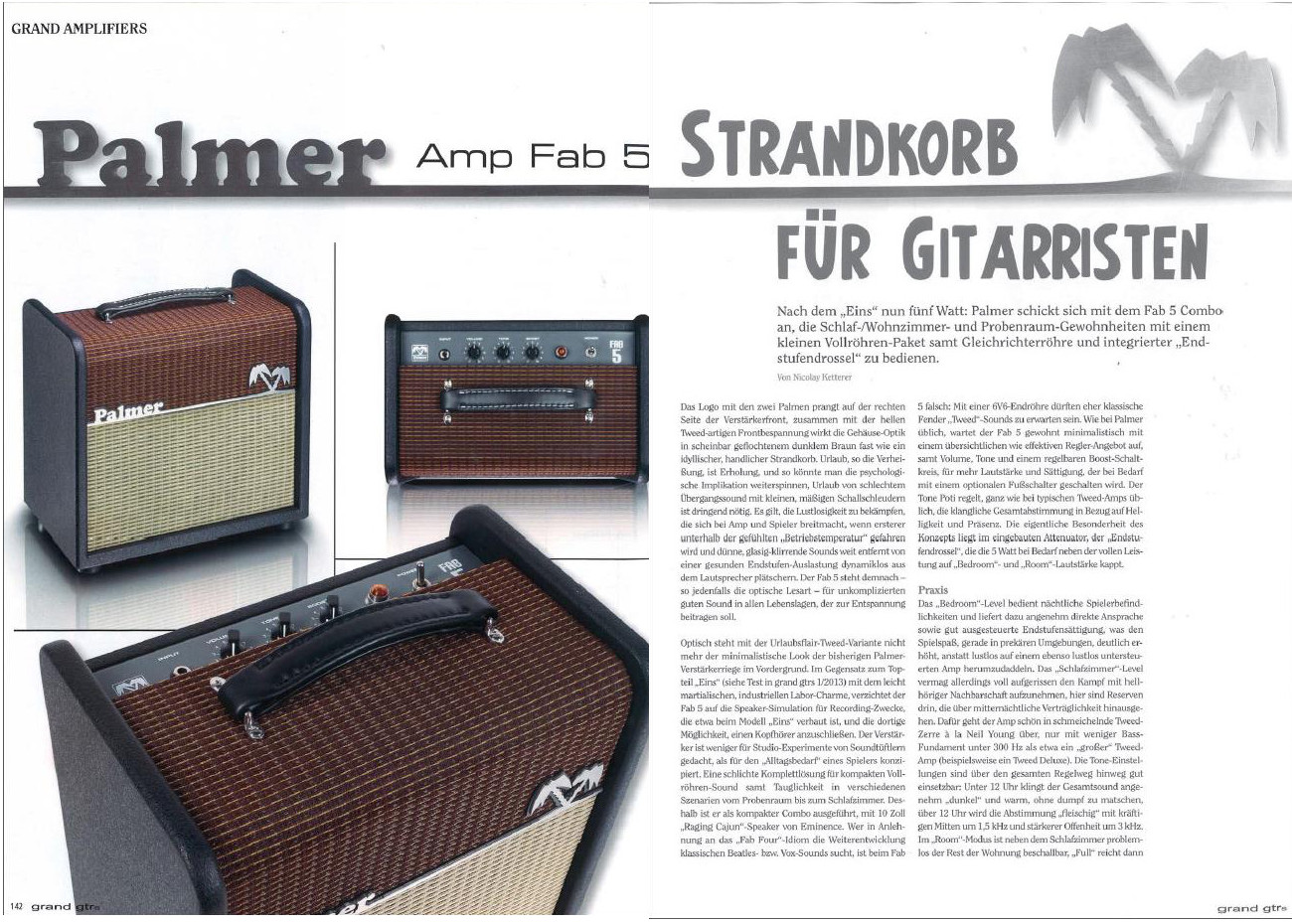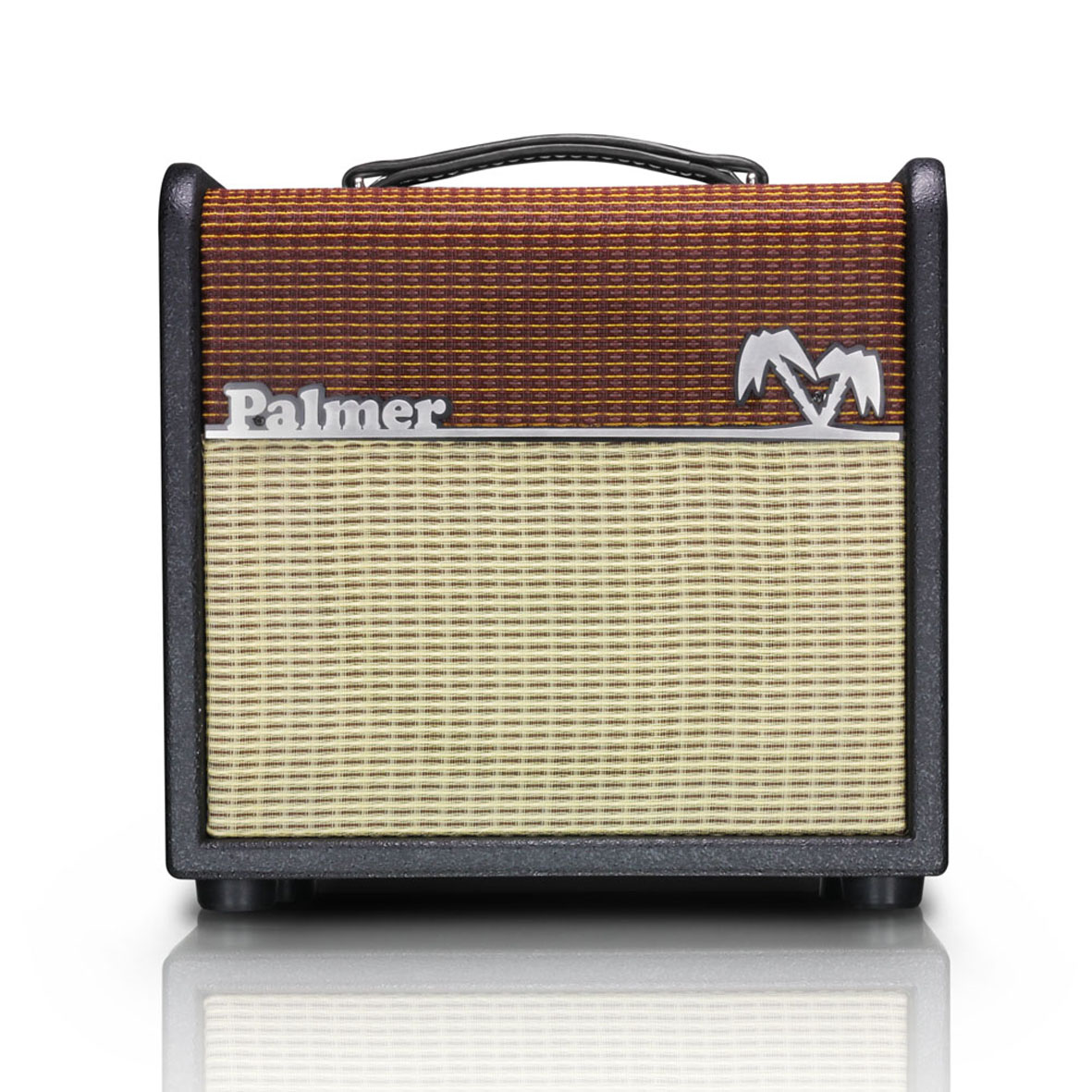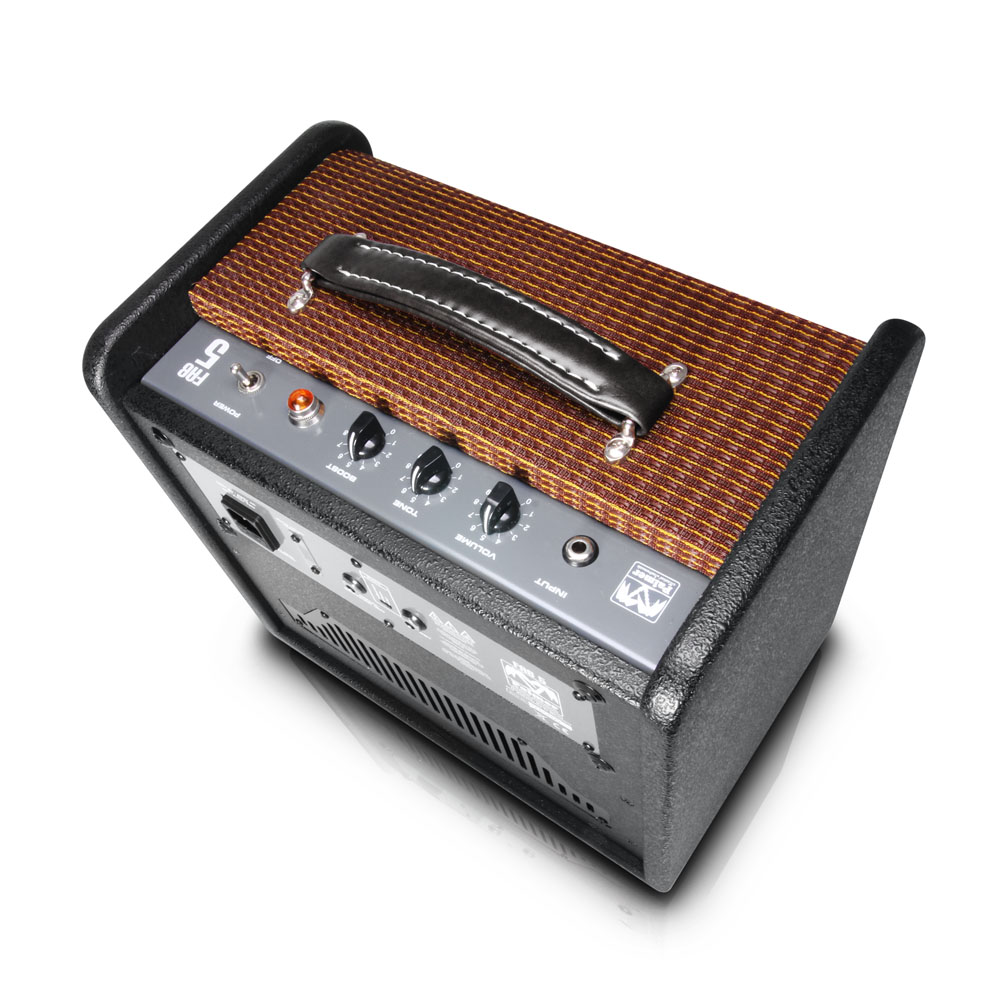Palmer Fab 5 – Wicker beach chairs for guitarists – Test report by Grand Gtrs
After the “Eins”, now comes the five watts version: With the Fab 5 combo, Palmer aims to provide the bedroom/living room and rehearsal room with a small all-tube package including rectifier tube and integrated “power amp choke”.
The logo with the two palm trees emblazoned on the right side of the amplifier front, along with the bright Tweed-like front covering in seemingly braided dark brown almost resembles an idyllic, handy wicker beach chair. It reminds us of holidays and the promise of rest, and so you could imagine the psychological implication: rest urgently needed from bad transition sound with small, moderate noise spin cycles. It is time to combat the listlessness which takes hold of amps and players, when the former is operated below the perceived “operating temperature” and thin, glassy clanking sounds, far removed from a healthy load of power amplifiers, are emitted from uninspired speakers. The Fab 5 thus stands – at least from its looks – for uncomplicated, good sound in all areas of life, contributing to a sense of overall relaxation.
Visually, the minimalist look of the former Palmer amplifier models has been abandoned for the sake of the holiday atmosphere Tweed variant. In contrast to the model “Eins” (see our test in grand gtrs 1/2013) with the slightly martial, industrial laboratory charm, Fab 5 renounced the speaker simulation for recording purposes, which was installed in the model “Eins” for example, and the ability to connect a set of headphones. The amplifier was designed by sound tinkerers for the “everyday needs” of a player, and less so for studio experiments. A simple all-round solution for compact all-tube sound and usability in various scenarios from the rehearsal room to the bedroom. That is why it was designed as a compact Combo, with a 10 inch “Raging Cajun” speaker from Eminence. For those who are looking for a further development of classic Beatles or Vox sounds, reminiscent of the ‘Fab Four’, the Fab 5 is not the way to go: with a 6V6 tube, you should rather expect classic Fender “Tweed” sounds. As usual with Palmer, the Fab 5 presents itself in a minimalistic way, with a clear and effective array of controllers for Volume, Tone and an adjustable Boost circuit, which, if required, delivers more volume and saturation via an optional foot switch. The Tone potentiometer regulates the overall sound in terms of brightness and presence, as is usually the case with typical Tweed amps. The actual specificity of the concept lies in the built-in attenuator, the “amplifier choke”, which caps the 5 watts volume from full power to “Bedroom”- and “Room” level, when required. 
Practice Run
The “Bedroom” level operates within night-time limitations and delivers a pleasantly direct approach and well controlled power amp saturation; this makes the playback fun, specifically in precarious environments, with a significantly increased volume rather than fiddling around on an equally listless under-driven amp. If fully turned up, the “Bedroom” level is able to take up the fight with the neighbourhood: the reserves to go beyond midnight compatibility are readily available. To achieve this, the amp transitions into a flattering Tweed distortion à la Neil Young, only with less bass foundation below 300 Hz than a “larger” Tweed amp (for example, a Tweed Deluxe). The Tone settings are suitable over the entire available spectrum: below 12 o’clock, the overall sound is pleasantly “dark” and warm, without dull indifference; beyond 12 o’clock, the sound will be “meaty” with strong mids around 1.5 kHz, and a greater openness around 3 kHz. In “Room” mode, you can provide the sound for the rest of the apartment next to the bedroom; “Full” is then sufficient in combination with moderate drums, as Palmer themselves state. In “Bedroom” mode, it becomes clear how well designed the power amp distortion for the “Fab 5” is. After that, you don’t really want to do without. And the “amplifier choke” is also a success, because its work is performed in a wonderfully unspectacular way. The “scaled-down” amp still sounds good and lively, compresses pleasantly, without any perceived artefacts “squeezing the sound”. The Boost circuit does exactly what you would expect in a Tweed amp; a light to strong boost of the distortion behaviour and of the lower mids around 500 Hz, which also increases the volume. It is the typical effect that increases the playback fun and delivers greater compression, so that by direct comparison, the amp sounds almost pale and sober without it. With an increased power amp saturation, the effect comes clearly into its own; the Booster makes the difference between distorted saturation and “creaking”, earthy Tweed distortions.
Tweed is the phonetic keyword of the Single-Ended power amplifier: with “meatier” openness and sweaty sounds in the style of Johnny Marr from “The The” or even Hooters sounds à la “Johnny B”; here the class A overtones come to fruition. With the “Eins”, it was the differentiated tiered clean sounds that contributed to its strengths; the Fab 5, however, provides a wide range of saturated to strong overdrive crunch sounds. Just as the Booster does not transform the amp into a high-gain Monster, clean sounds are elicited only to a limited extent; the Fab 5 is then simply not in the ‘sweet spot’, in its rightful domain, where it provides the most fun. It can achieve very clean sounds, however they sound rather dull and lifeless. Its strength lies in meaty, sweaty Tweed sounds, which are also assertive, not least thanks to the missing bass foundation. The Boost circuit can be remotely controlled with an optional foot switch which seems to be a sensible idea. In practice, I would want to leave the Booster always on as part of the successful basic sound, because it pleasantly enriches the sound aesthetics and the operation of the amp. A deliberate “volume boost” should come from an external upstream booster, if necessary. On this occasion, it would appear that the Fab 5 harmonises very well with different pedals, and thus, you can adjust the distortion level of the overall sound as desired.
Details
Manufacturer: Palmer
Model: Fab 5
Type: all-tube combo
Connections: input, output (8 ohms), foot switch connector for Boost circuit
Tested Using: Fender Esquire, Telecaster, Jazzmaster
Preamp Tube: 1 x 12AX7
Power Amp Tube: 1 x 6V6 (Single-Ended operation)
Rectifier Tube: EZ81
Output Power: 5 watts
Channels: 1
Controllers: Volume, Tone, Boost
Speaker: 1 x Eminence Raging Cajun, 10 inch
Feature: attenuator on the back for the power amp volume (“Bedroom”, “Room”, “Full”)
Price: € 449
Dimensions (W x H x D): approx. 36 x 35 x 23 cm
Weight: approx. 10kg
Conclusion
For those who have always been looking for a smaller Tweed amp, that is able to shine at home and in the rehearsal room with a rich power amplifier, Palmer offers a successful all-round solution with significant strengths in the mid-range crunch sounds. In doing so, the “airiness”, the foundation in the bass and the complexity of a second power amp tube are missing, in order to sound like the “big” Tweed predecessors. A combination of loud and quiet (with integrated “power amp choke”) is also provided by Tone King with the “Falcon” (test grand gtrs 1/2013). This amp, in the boutique segment, is slightly more complex in its tonal resolution, but also significantly more expensive. As their own five watt alternative, Palmer supplies the adventurous user with the “Drei” top part, which brings together three five watt power amplifiers, which can be operated in parallel and mixed. Thus, each amplifier can accommodate a different tube type.
For more information on this product:
http://www.palmer-germany.com/mi/en/FAB-5-5W-All-Tube-Guitar-Combo-PFAB5.htm
Source: Grand gtrs, Germany, December 2013
Leave a Comment
You must be logged in to post a comment.











